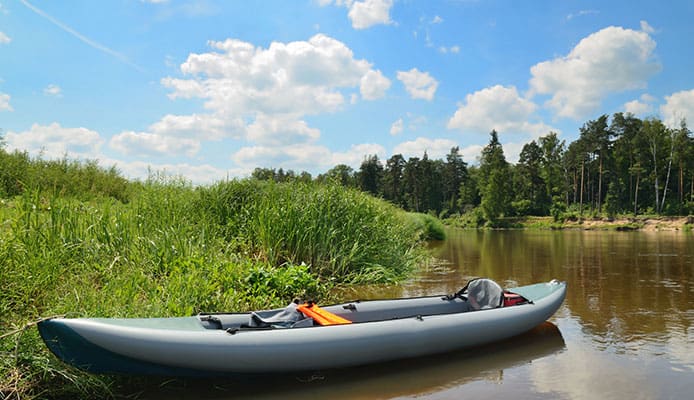
If you paddle using a rented or borrowed kayak quite often, you may have found yourself thinking about buying your own boat. But as many first-time kayak buyers soon find out, purchasing a yak isn’t always as straightforward as it first appears to be.
There are certain details you need to consider to ensure you are spending money on a boat you will enjoy using. For instance, you need to do your research on inflatable vs hardshell kayaks, the two major constructs in the market today, and decide which type to go for based on the features you are looking for and the type of kayaking you intend to do.
In the spirit of helping you get the best value for your money, we do a comprehensive comparison between inflatable vs rigid kayaks, so you can understand each design’s pros and cons and make an informed buying decision. Read on!
Inflatable Vs Hardshell Kayaks: Key Differences Explained

Obviously, inflatable kayaks and hardshell kayaks are two very different water vessels. Below are the core features that make each design better than the other.
1. The Construct
Hardshell kayaks are what most people typically think of whenever they hear the term ‘kayak’. These have a rigid frame made from solid materials like polyethylene plastic, fiberglass, and thermoform ABS. They are generally heavy, sometimes weighing up to 60 pounds. There are also wooden kayaks available, though they’re not as popular as yaks made from these three materials.
Inflatable kayaks, on the other hand, are constructed from PVC, Hypalon, nylon, or polyurethane. These are lighter than their hardshell counterparts, typically weighing about 30 pounds. They need to be inflated with a manual or electric air pump before use.
2. Durability
Another aspect you should consider when choosing between an inflatable kayak vs hardshell is durability. In general, hardshell kayaks, particularly the ones made from high-quality polyethylene, are very strong and durable and are considered the sturdiest among the different types of kayaks available. These kayaks will have no trouble bouncing off from rocks and other debris in the water. However, this does not mean they are invincible and will not get damaged after taking significant amounts of abuse.
In contrast, inflatable kayaks are considered not so durable. However, over the years, this theory has proven more of a misconception, as with the new advancements in technology, inflatable yaks have grown to be quite resilient. Modern-day inflatables are tough and sturdy and can take a significant amount of impact before showing signs of damage.
For instance, inflatable kayaks for whitewater can take a good amount of beating. Those made for fishing can handle hooks, fins, and even knives without getting damaged. It should also be noted that the coast guard and military use inflatable boats all the time for their patrol and rescue missions.
However, these cases are only true for high-quality inflatable kayaks made from Hypalon or polyurethane. So if you’re willing to spend more, you will definitely find an inflatable kayak that is strong, durable, and will be up to whatever kind of kayaking you want to do.
3. Price
When it comes to inflatable kayaks vs hardshell kayaks prices, the latter is generally more expensive. Inflatables nearly always cost less than half the price of their hardshell counterparts.
Hardshell kayaks can cost anywhere between a few hundred dollars to several thousand dollars. Besides, polyethylene kayaks are significantly cheaper than composite or thermoform ABS kayaks.
4. Maneuverability
One of the most often cited advantages of hardshell kayaks over inflatable kayaks is their excellent maneuverability. The major reason for this is that hardshell sit lower in the water. Another is that they are much heavier than inflatables, which means they don’t get tossed around as easily. Besides, hardshell kayaks are narrower so it is easier for kayakers to lean to one side, paddle, and turn the kayak towards the desired direction.
Paddling or steering an inflatable kayak should pose no problem when you’re on calm waters like in ponds, lakes, or slow-moving creeks. It’s a different story, though, when you are adventuring choppy ocean waters and fast-flowing rivers.
Still, inflatable kayaks are getting better and better over time. Many manufacturers are incorporating designs and using materials that can improve their inflatable kayak’s maneuverability in moving waters, which is the case with many inflatable kayaks for whitewater kayaking. It’s only a matter of time before we see inflatables that have the same responsive handling that hard shells offer.
5. Portability
The portability of your kayak will highly depend on the materials it is made of. Considering the construct of kayak inflatable vs hardshell, hardshell yaks are quite heavy, making them less portable than their inflatable cousins.
Inflatable kayaks, in contrast, are extremely lightweight and portable. Even children should have no trouble carrying these boats around. When deflated, an inflatable kayak will fit nicely in your car’s trunk or even in the back seat, which is perfect if you don’t have a kayak roof rack or intentions of having one installed on your vehicle.
Deflated kayaks can be carried around in a large duffel bag or backpack (which may or may not come with the kayak when you purchase it). This can be helpful if the parking lot is quite far from your launch area.
6. Storage
Hardshell kayaks are big and bulky, which then makes storage a challenge. But that doesn’t stop kayakers from getting one because there are plentiful convenient kayak storage tips for hard shells available if you have space for one.
In general, it is best to have indoor storage space like a garage, shed, or basement for your hardshell kayak since this is still the safest storage option and because it offers complete protection from the weather. This doesn’t mean, though, that you can simply leave your kayak on the floor; it will certainly damage the boat. What you should do instead is to get a kayak rack or have a suspension system installed in your ceiling where you can hang your boat.
But storage for inflatable kayaks is much easier. An inflatable kayak can be stored just about anywhere in your home. Unlike hard shells, inflatables can be deflated and packed in a storage bag, which you can then just place on a shelf or even push under the bed.
Still, certain steps must be taken to ensure inflatables are well protected from dust, mold, and rodents. Also, if you’re storing yours for a long-time, consider taking it out of its bag at least once every few months and let it air outside.
Which Kayak Is Good For You?
Now that you know the core differences between inflatable kayak vs regular kayak, which one should you invest in?
Well, if you are looking for a kayak that offers solid durability, then a high-quality polyethylene kayak is something you should consider. This would make a perfect choice if you will be adventuring rocky beaches. It is also a good choice if you are planning to paddle in rough waterways (i.e. Class III and higher rapids) where you expect the boat to be banged around often.
Also, if you’re planning to use your kayak for an overnight kayaking trip, a hardshell would be a better choice. This is because the rigid frames of hard shells allow the manufacturers to increase the storage area both in the front and in the rear of the boat, providing you with ample space for your camping gear and gadgets.
If you are a kayak angler who likes fishing for trout or bass in lazy rivers, then an inflatable kayak would make a nice choice. It would also be perfect if you’re just looking for a vessel to take you out in the middle of a calm lake where you can enjoy the serene surroundings.
Inflatable kayaks made from Hypalon and polyurethane can be tough and suitable for daring whitewater expeditions. However, they are still made of fabric and rubber, which means they are still at risk of puncturing especially if you constantly crash against razor-sharp rocks.
Because they are cheaper, inflatable kayaks are also excellent for someone who is just getting into the hobby and unsure how far they want to progress in the sport. The same is true for not-so-serious kayakers who only take their kayaks out once or twice a year. Inflatables would be perfect for kayakers who don’t have storage space for hardshell kayaks too.
Globo Surf Overview
When it comes to choosing between inflatable vs hard kayaks, different paddlers will have different opinions about which design is best, but the ultimate choice will all boil down to your personal preferences.
As you can see above, both hard shells and inflatables have their own pros and cons. As such, the choice between inflatable vs hardshell kayak will depend on the trade-offs that you are willing to make. Nonetheless, whatever type you choose, be sure it meets your needs, and importantly, it is designed for the type of kayaking you intend to do.
More Kayak Reviews:
- Kayak Shoes
- Kayak For Dogs
- Kayak Drysuit
- Stand Up Fishing Kayak
- Kayak Cockpit Cover
- Kayaking In Illinois
- Kayaking With Dog
- Wilderness System Tsunami
- Kayaking In CT
- Old Town Loon Kayak

